https://commons.gc.cuny.edu/groups/art-1010-fall-2018-930am/forum/topic/how-to-make-a-blog-post/
Humanism in Greek and Roman Art
Humanism is a system or a way of thinking that emphasizes the value, interests and dignity of human beings. Humanism is illustrated through Greek and Roman Art because the art of Greece and Rome are statues and figures of young nude warrior men and how their physique and body is idealized and supposed to look like. However, Mesopotamian and Egyptian Art is different from the Greek and Roman Art because Mesopotamian and Egyptian Art are not statues and figures of muscular nude young men instead they have paintings and statues of pharaohs, their hierarchy system, and gods. The Greeks originally created their statues and works of art out of bronze using the lost wax technique so it could later on be melted down if necessary for weapons, tools, and etc. The Romans copied the Greeks works of art but instead of bronze the Romans made their statues out of marble which weighed much more. Disparate from the Roman statues made of marble and bronze and representing figures of young fit male warriors the Mesopotamian s and Egyptians also made statues but they were made out of stone and it was not as human as the Greeks and Romans, instead the statues were of Gods including human figures mixed with animal parts or pharaohs in loin cloth and fake beards. Greek and Roman Art and Mesopotamian and Egyptian Art have several similarities and differences when portraying humanism. Some examples of Greek and Roman Art is Kouros which represents the ideal physically fit male warrior of the time and later on changes into a more tone, smooth and better looking figure with a difference in hair and stance otherwise known as Doryphoros. Unlike the Greek And Romans, Mesopotamian and Egyptian art portrays figures like Anubis and the Sphinx which are part human and part animal figures, Anubis has the head of a jackal and the body of a man and is the god of the dead. The Sphinx has the head of a human and a body of a lion. Mesopotamian and Egyptian Art also show the hierarchy and the social status with the pharaoh shown to be the biggest and on the top while accompanied by his followers who are of similar or smaller size and the slaves which are the smallest and the lowest.
Blog 8 – Humanism in Greek & Roman Art
Humanism is an overall shift to the idea of what humans are capable of and can produce, rather than relying and basing argument on divine or supernatural factors. This was a shift in mindset, practices, and certainly artwork. A major factor in developing the humanistic ideology was the Greek gods and goddesses. Greeks identified that their gods had flaws and faced issues that mortal beings faced. As a result, it allowed the individuals to resonate more with the gods, but also rely less on gods and more on their own capabilities. Greek and Roman artwork greatly illustrates humanism when compared with ancient Egyptian and Mesopotamian artwork. To begin with, Greek and Roman artwork are much more detailed than Egyptian and Mesopotamian. Greek and Roman sculptures had a more realistic appearance and looked like an actual person one could recognize. There was more emphasis on the face with distinct facial features and expressions, but also details in places one wouldn’t pay attention to right away such as fingers, feet, muscles, and posture.
To illustrate the difference, an example of Egyptian art is Anubis and mummification. Anubis was the jackal-headed god of embalming that watched over the dead. This is a good example in comparison to Greek and Roman artwork because it’s 2 dimensional, so there is less room for detail as opposed to a sculpture. However, what the art represents is also a representation of Egyptian culture. The Egyptians were very focused on gods and religion and they would base their thinking on divine or supernatural power. By presenting art with a half-human half-jackal being who helps individual be closer their god, the art is employing divine features rather than humanistic.
An example of Greek art is Kroisos from Anavysos which was simply a human statue of a man. However, the detail included in the sculpture employs the elements of humanism. There was less focus on any divine or religious connection, and more emphasis on human features. Body parts such as fingers, toes, and muscles, as well as posture and expression all showed that this was an actual person who was most likely modeling for the artist. Nonetheless, humanism in this sculpture shows the differing ideals that the Greeks and Roman’s had compared to the Egyptians and Mesopotamians.
Blog Post Humanism
To me humanism is the emphasis on how extraordinary, and unique the human race is. By highlighting the best physical, emotional and spiritual qualities of humans, humanism creates the argument that humans should not only be celebrated, but even goes as far to suggest that humans should be revered as a deity of some sort.
Some ancient societies however had slightly different definitions from one another of what humanism was. Therefore, their ways of portraying it, more specifically in their art had slightly different emphasis on different things. To illustrate this point we will com pare the art work Ancient Greece nd Rome to that of Mesopotamia and ancient Egypt, starting first with the latter.
Mesopotamia and ancient Egypt art channeled their view of humanism through exalting their gods and the after life. Often times we see paintings and sculptures we can observe that the Pharaohs and kings are being praised as gods. Their exotic head dresses, their upright posture upon the throne they are sealed on, along with their powerful case into what the view are all defining characteristics of this type of art. As if to say ” this being who happens to have the body form of a man, dare not be perceived as an ordinary human being; but rather kn9ow it is a god who has taken up a human form to serve and be relatable to you. The second part of humanism that we find in Mesopotamian and Egyptian art is the foglight of the after life.we see in paintings ( Such as the one with the scribe) that everyman in his life time strives to live a balanced life. this way when they die they will be found worthy to obtain eternal life with the gods. so we see through his channel that the emphasis on humanism again isn’t necessarily the humans them selves, bu the humans strive to be a man- like god.
Unlike Mesopotamian and Egyptian art ancient Greece and Rome take the focus off the gods and place it solely on humans, when channeling their perception of humanism through art. In the statues that we viewed in class we couldn’t help that notice that the male figures were almost always nude. As we discussed, to other societies being nude would be a sign of shame. But to the romans nudity was a sign of pride, especially for a young male warrior or athlete. it displayed humanism as ” being proud of the skin you’re in and showing of EVERY ACCOMPLISHMENT you have achieved” Humanism through art in Ancient Greece and Rome didn’t look to deity’s for confirmation of how amazing and unique humans are, but rather looked to themselves.
Blog Post: Humanism
Thus far the Ancient Worlds that we have learned about in class tended to create works of art that were more naturalistic instead of humanistic. Examples of Ancient Worlds that focused on naturalistic art were Mesopotamia and Egypt, where there was more of a focus on the Gods and that everything else was surrounded by the Gods. In contrast, Greek and Roman art focused on humanism. Humanism focused and emphasized humans as the “main object” of the world and that instead of Gods, humans were, in a way, at the center of the universe. Humanism focuses on human values, beliefs, and individuality; and that humans have the capability to be good. In terms of Greco-Roman art, humanism meant putting an emphasis on the human potential, as well as the human body.
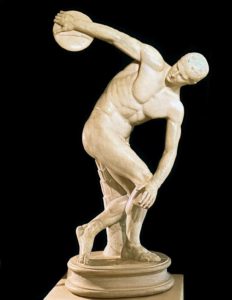
For example, in the Ancient Egyptian sculpture, Seated statue of Pharaoh Seti (*picture would not upload), humanism is not portrayed. In this sculpture, the human body is not emphasized and instead his rank his emphasized. For this piece of artwork, the eyes are instantly drawn to the Pharaoh’s headpiece, the object in hand, and his feet that are on top of an object in order for them to not touch the ground. All of these observances can instantly make the viewer come to the conclusion that this person was in fact a Pharaoh and therefore of very high rank. In addition to that, the Pharaoh’s body is not emphasized, and instead the viewer can see the outlining of the garments that the Pharaoh wears, once again demonstrating social class and power.
In contrast, in this Greek sculpture, Discobolus, humanism is very evident. Most noticeable is that the naked human body is on display, clearly showing human emphasis. The Greeks saw the display of the human body as something natural and something “show off” and take pride in. Their bodies showed their strength and exuded their power. The Greeks did many things in the nude, as it was considered the norm, even the Olympics were done in the nude. This sculpture does not put an emphasis on rank or social class, it is ambiguous and is left for the viewer to assume.
Humanism in Greek art
Humanism is a concept that emphasizes “attaching prime importance to human(s) rather than divine or supernatural matters”, it is the study of human beings. In art, Humanism manifested through paying more attention to Human detail to make them look more human, through highlighting and detailing humanistic traits such as giving hair more detail- making it more realistic, making bodies more big and detailed (highlighting things such as stance, genitals, muscles etc). This was very important in the ancient times because it was a large switch from encompassing life and its meaning to supernatural and divine figures. Humanism presented more realism in the people’s lives. Humanism helped not only improve the quality of art and sculptures; however, it also helped show the evolution of art and how it was done before and how it developed.
Greek and Roman art, portray Gods as more human;
(Statue of Kouros)
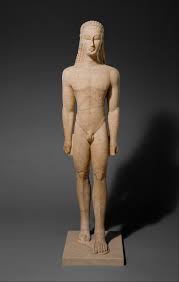
whereas, Egyptian and Mesopotamian Gods are portrayed in a more dehumanized way having animal heads etc, however only because they were seen as divine and not as equivalent to humans, but superior. Egyptian art had more of a mystical feel to it rather than a realistic one.
(Painting of Anubis, a God with a jackal head)
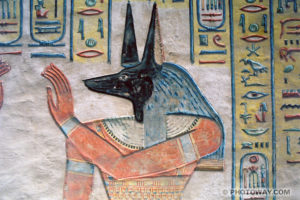
Here is a juxtaposition of Greek and Egyptian art:
(Marble statue of Kouros vs. King Menkaure and Queen statue)
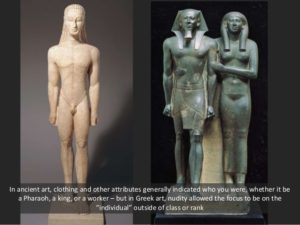
Clearly the inclusion of Humanism was revolutionary because “it valued humanity in that it began to place human beings @ center of moral and social concerns and gave more valoration to things such as the human body”.
Humanism in Greek and Roman Art
Humanism is a system of thought and beliefs that emphasized the value of humans and what they can do. Humanism in Art of Ancient Greece and Rome emphasized epistemology and created a central focus on human experience. Through various Greek and Roman art, you are able to see the aesthetics and natural beauty shown through sculptures of humans. In contrast, humanism in Mesopotamian art and Egyptian art can be a little different. Although you may see similar features in humanlike sculptures, the subject matter of Mesopotamian and Egyptian art was centralized around an appreciation for kings and gods. Art in Ancient Greece and Rome would depict ideal figures of men and glorify athleticism and sports whereas in Mesopotamian art and Egyptian art, the focus was more around the church and kingship.
In the sculpture of Doryphoros, you are able to see an emphasis on a natural standing pose called contrapposto. This naturalistic representation of the human body shows the focus on human experience and appreciation of the human body. The sculpture being nude also reveals a cultural pride whereas in Mesopotamian and Egyptian art, nudity is rarely seen as a sign of strength. The tilt in the Doryphoros’ arm is supposed to be holding a spear which can symbolize the strength in military and war. In contrast to art of Ancient Greece and Rome, the Assyrian Palace Reliefs show many differences when compared to the sculpture of Doryphoros. The Relief of King Ashur-nasir-pal ll and a Winged Genie reveals the king and a winged genie performed some sort of ritual. Although they are shown as muscular, both the king and the genie are clothed from head to toe in garments whereas the sculpture of Doryphoros is nude. Art of Ancient Greece and Rome clearly emphasizes the human experience whereas art in Mesopotamia and Egypt focused more on worshipping gods and kings.
Humanism
Humanism is defined as a philosophy based on the importance and dignity of each human. Humanism started in Italy, due to their innovative way of life; the increase of trade stemmed new ideas. People who practice Humanism are called humanists. Humanists essentially believe that humans have control over their lives and have the ability to question everything around them. Humanists usually study classical art, government, architecture, language, history and poetry. Humanism in art refers to the change a person could bring to art. In Greek and Roman art, the primary focus is man, while in Egyptian and Mesopotamian art articulates around the art of a higher power.

This Greek sculpture of Discobolus depicts an image of a man. Compared to Ancient Egyptian art, this image compares to an image of a human being while Egyptian art makes little resemblance to a actual human. Also the techniques of the sculpture differ from Ancient Egyptian sculptures since they are from different time periods the different techniques display different images. This Greek art shows a masculine warrior, which most Greek sculptures portray. This sculpture illustrates an image of a strong and powerful man, the way the sculpture is presented shows the slight feminine touch of the sculpture.
Humanism and Art
The study of humanism is to understand the quality of human life. It’s a system of thought used constantly throughout the artistic culture where its main focus is on humans and their values, capacities, and worth. Humanism can be used in literature, art, and even in civilization, however, the Greek and Romans have made this concept their central focus in art and in life. In the Greek and Roman culture, when it comes to art, may it be the being of a man or woman, the focus is shifted upon the anatomy and pure physicality of that being. Individuality is clearly expressed through each line drawn of chiseled within, as well as, uniqueness. Both, the artist’s individuality is expressed along with the artist’s subject. In comparison, Mesopotamia and Egyptian art focus on the power of the deities, ancient civilization, and God-like representations. The Greek and Romans attention was highly diverted towards the physicality of the human individual.
From Mesopotamia and Egyptian art, comes The Standard of Ur. This is a small trapezoidal box with two sides. Each side is covered with figurative representations and mosaics of ancient life. When looked upon closely, there are three levels that represent life differently. The most lower level portrays the subjects as slaves working for their master, delivering something like a gift for their god. The upper level of The Standard of Ur shows a being larger than the rest of the subjects who breaks the barrier of the upper border. In Egyptian society, a God is commonly represented in art as the largest being visible, which is explains the unusually large figure in this art piece. This God is presented as the almighty being, while all his subjects are kneeling and sitting before him.

Although the tablet allows current society to take a quick look into past civilization and its views on culture, the Greek and Romans had a different belief of what art should depict. They thought that art should be more human-based rather than God-like to express the reality of being human. An example of this would be the statue of Kouros. This is an ancient sculpture representing the nude male youth in an upright stature. In Greek, the name Kouros even means ” youth, boy, especially of noble rank.” The Kouros statue shows a nude male standing straight on both feet, one foot forward, and one foot backward. Anatomically when standing this way, it is quite uncomfortable, however, this was how the ideal male youth was depicted. It is also portrayed as nude because, in the Greek culture, nudity was deemed as prideful and as showing a sense of unimaginable strength. As noticed before, Kouros is standing up straight, but also has a very stiff and rigid stance to him.
This was believed to be the way of humanism in Greek and Roman culture as opposed to Egyptian culture that pertains to a constant higher power or worshiping.
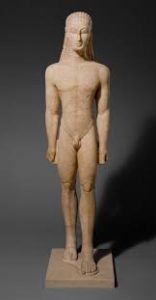
Blog #8: Humanism in Greek Art
Humanism is the system or movement of human beings. In terms of art, humanism shifts the focus in where man becomes the agent for change. It emphasizes the value and individuality of humans. In Greek and Roman art, humanism is very common as it is the main focus in majority of the pieces of art. In Egyptian and Mesopotamian art, they focus more on a higher power that is greater than mankind where as in Greek and Roman art, they focus more on the human itself.
On the left we have the Sumerian art of the Standing male worshipper and on the right we have the Greek art of the Kouros of Kroisos from Anavysos. In the Sumerian art piece, it represents a religious standpoint. The figure is a sign or a symbol of a higher power. The figure is covered and has detailed lines below (almost like a dress or a robe). In Mesopotamia, nudity was a sign of humility which is why the figure below isn’t nude. The eyes in the male worshipper piece are wide and distinct and is one of the first things that draws your eyes. In the Greek art piece of the Kouros of Kroisos from Anavysos, the figure has more features of a human than of a higher power. It has one foot in front of the other and is completely nude. For Greek, nudity was a sign of culture and pride. The men and boys that were sculpted all appeared nude as it was a way to show strength and power. The eyes in the pieces aren’t as distinctive as the male worshipper. In both art pieces, they have very intricate waves and beads/braids to represent the bread on the Standing male worshipper and the hair on both the Kouros of Kroisos from Anavysos and the male worshipper. Both pieces are also proportionate in symmetry and are stiff.







